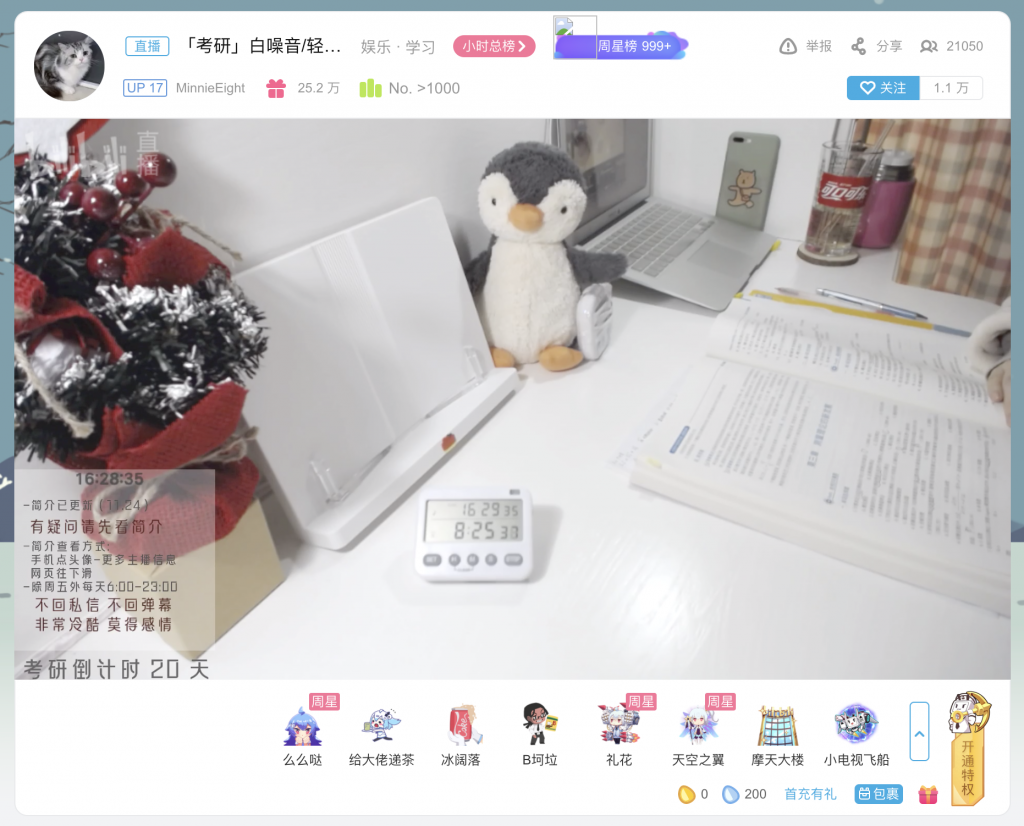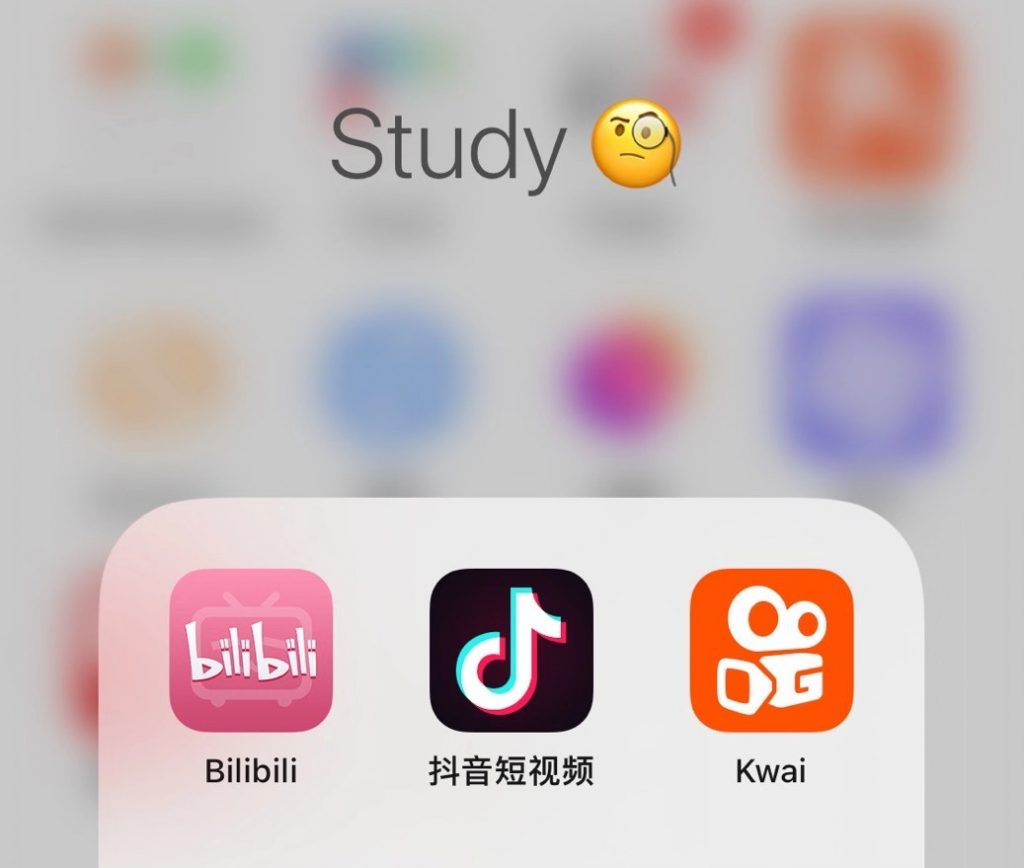#Study with Bilibili
On a normal Wednesday afternoon, a Chinese student who goes by the virtual nickname of MinnieEight is studying for the national 2020 postgraduate entrance examination. She’s working on an exercise book, paired with her Mac laptop, a bouquet of flowers, and a furry toy penguin on a white desk.
From time to time, she turns the page or writes something down. The air is filled with the sound of a crackling fire—which is quite relaxing and helps improve her concentration.
It looks like a normal study scene, but there is an exception: every minute of her afternoon is being live-streamed and followed by more than 10,000 viewers on Bilibili, a Chinese video-sharing platform well-known for its anime, comics, and gaming-centric content (ACG). The picture is nearly still. And MinnieEight? She only reveals her hands while holding a pen on the screen.

She is one of the 600 streamers who showcase their study routine with the hashtag “Study with me” on Bilibili at the moment. Thousands of viewers are also preparing for their exams, learning English, or just reading quietly, and a virtual companion makes them feel less lonely.
It’s a new feature of Bilibili, which was born to be a platform totally focused on entertainment, with thousands of popular TV shows and movies, especially anime and fantasy series, characterized by the use of danmu, or “bullet comments,” a user conversation system where messages are directly displayed on top of the video as it plays.
Bilibili was previously not parents’ favorite place but has been recently trying to add the idiosyncratic “study community” to itself, supported by millions of education-related videos uploaded by its users ranging from computer science, psychology, finance, foreign language learning, and Adobe Suite practice skills.
The platform, which has gained extreme popularity over the years among Chinese youngsters, especially the so-called Gen Z, is now betting high on the education market. This year, over 20 million users out of its overall 128 million user base have accessed Bilibili, or “B site,” as fans call it, for online study activities in live streaming rooms or recorded tutorials, said the company. This number was more than double that of students who attended the National College Entrance Examination (NCEE), commonly known as Gaokao, in 2019.
In addition to the live streaming study rooms, users can also find a variety of free recorded courses on the platform. For example, a program called “Abnormal Psychology” taught by a Peking University professor is one of the most viewed classes on the platform. The collection has more than 300 million views, 150,000 “thumbs up”, and over 26,000 bullet comments.
Short-video apps are also entering the online education industry
Bilibili is not alone. Kuaishou, known as Kwai outside of China, one of the world’s largest short-video and live streaming apps, claimed to have hosted nearly 1 million educational content creators and over 200 million educational short videos, attracting more than 100 million users on average every day, as of October 2019.
Kuaishou’s archrival Douyin, ByteDance’s short-video platform (TikTok’s domestic version), has also embraced all manner of educational short-videos, especially teenager-facing ones. Earlier this year, it partnered with national-level organizations like China Research Institute for Science Popularization, and rolled out a plan called “Dou Zhi Plan,” to encourage more education-relevant content by giving out incentives to content creators.
In the battle to compete for viewers’ time, these platforms are all taking steps to embrace the education sector to further drive revenues and to diversify their income streams.
A new market to drive revenues
It didn’t come as a complete surprise when Bilibili announced that it started to beta-test its service “Bilibili Class” at the end of October, tapping into the paid courses business, covering fields from pet-keeping, paper writing, video editing, PowerPoint tutorials, among others.
One example of these classes is the one curated by Zhang Zhaozhong, a Chinese military theorist and admiral who opened a series of courses named “International Strategy.” Viewers have to pay RMB 60 (USD 8.5) for ten episodes, and already nearly 50,000 users have bought the package out of his huge following of over 3 million fans on Bilibili.
Bilibili class is a new alternative for the site to generate revenues from its user pool. In the third quarter ended September 30, the company had 7.9 million monthly paying users, doubling last year’s level, but only accounting for just about 6% of its total user base.
Bilibili booked net revenues of RMB 1. 86 billion (USD 260.1 million) in the third quarter, registering a 72% increase year-on-year, while revenues from its core-business—mobile games—inched up only by a quarter. Other segments including live broadcasting and e-commerce both saw a three-digit surge, 167% and 703% year-on-year, respectively.
Unlike Gen Z-targeting Bilibili, Kuaishou, a platform with 210 million daily active users (DAUs), is encouraging its users to upload educational videos suitable for a wider range of viewers, such as cooking tutorials, electrician training, and even farming courses. In the Kuaishou Education Report released in October, the firm said that its users have a mounting need for content related to education, such as agriculture, vocational education, and school subjects.
For example, a Kuaishou blogger named “Jiali Sister Bakery,” who posts cooking tutorials and gathered around 250,000 followers on the platform, is now also offering paid content for as low as RMB 2 per episode. Her classes are usually short, engaging and practical, in where she explains how to prepare a special hot sauce or other particular recipes.
Another model is “Modern Agriculture Mr. Xu,” a Kuaishou influencer with 1.3 million followers. He is well-known for his videos where he teaches users how to do farming, and he also presents a paid course with a focus on training farmers to set up small businesses with the help of the internet.

Through this feature, Kuaishou offers a simple method for its creators to monetize videos and live streaming. According to the firm, the number of its users who have paid for educational content hit 1.6 million, with a month-on-month increase of 95% by August 2019. The company added that more than half of its content creators sold courses in the format of short-videos, and 95.2% of them gained money.
Douyin hasn’t launched paid courses yet, but its gigantic user pool of 320 million DAUs has snagged the attention of educational institutions which consider Douyin a necessary tool to acquire more students, and the platform is benefiting itself ad-wise.
English learning app Liulishuo has gathered more than two million followers on its Douyin profile by posting catchy ads and videos. China’s online education startup Yuanfudao, or “Ape Tutor” in Chinese, reportedly poured over RMB 100 million into ads for Douyin’s news feed.
In the meantime, to enrich its content, Douyin gave privileges to its individual educational content-makers, allowing them to upload five-minute-long videos, while the time limitation for a normal user is 60 seconds. “Teacher Xiang Bo,” a middle school educator from southwestern Sichuan province, has attracted 6.3 million followers through clips of his lighthearted-style chemistry classes with the hashtag “Everything is chemistry.”
Ferocious entrants or supportive partners?
Paying for courses is anything but new. According to research firm iiMedia, the number of Chinese paying users for knowledge hit 292 million in 2018, and this number is expected to grow to 387 million by the end of 2019. By 2020, the paid knowledge market volume in China is predicted to reach RMB 23.5 billion (USD 3.2 billion), up 172% from 2018’s RMB 8.6 billion, according to industry data provider Zhiyan Research Group.
Although the booming paid knowledge market in the nation has seen a vast group of players like knowledge vendor Dedao, audio-sharing platform Ximalaya FM, and China’s largest question-and-answer site Zhihu, a dominant player has yet to appear, in part because most of these companies are focusing on niche markets.

Platforms like Bilibili and Kuaishou are still mostly recognized as entertaining virtual places for people to goof off, but now that they are aiming to also transform themselves into “teachers,” they seek to maximize their advantages to lure more learners.
A healthy sense of community is a boon for their rapid rise in the education sector. Users spontaneously upload quality cross-topic videos to enrich the platforms’ content ecosystem, and they later communicate with each other over this content, as in a small community. Platform operators thereby expect to foster this kind of “community culture,” and meanwhile, turn these resources into profit.
Currently, Bilibili is working on fleshing out the paid courses initiative Bilibili Class at a steady pace and is actively signing more productive and high-quality creators.
Kuaishou vice president Ma Hongbin said during the 2019 Global Education Summit that his company considers its educational content ecosystem as an infrastructure open to all professional institutions and individuals, paving the way for other players to associate with Kuaishou to provide educational content.
ByteDance, Douyin’s parent company, has also been making significant strides in the country’s edtech arena by developing and acquiring several education-focused applications, such as online education portal Dali Ketang (or “Power Class” in Chinese), and an upcoming AI-powered tutor for kids.
Clearly, former entertainment specialists Bilibili, Kuaishou, and Douyin are on their way to reshape China’s online education scene, either as strong new entrants or supportive partners to existing players.
It’s already late at night. In a Bilibili live streaming room called “Joy’s Study Room,” the picture is paused at a photo of Joy’s desk. More than 4,000 people are following.
“Good night,” Joy writes. “See you guys at 7 am.”
